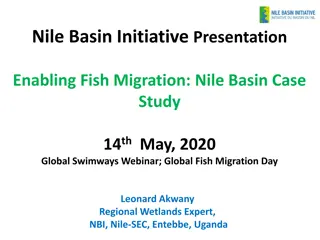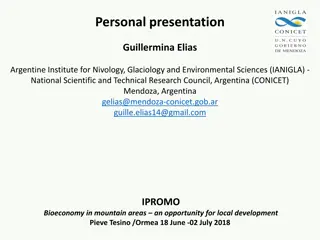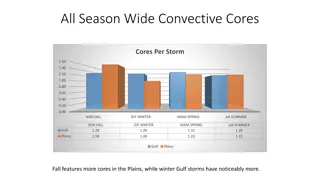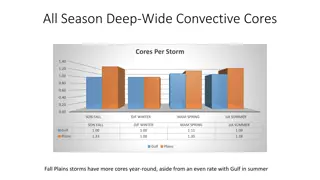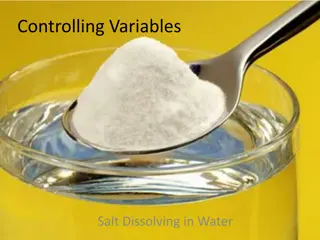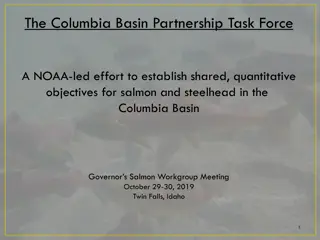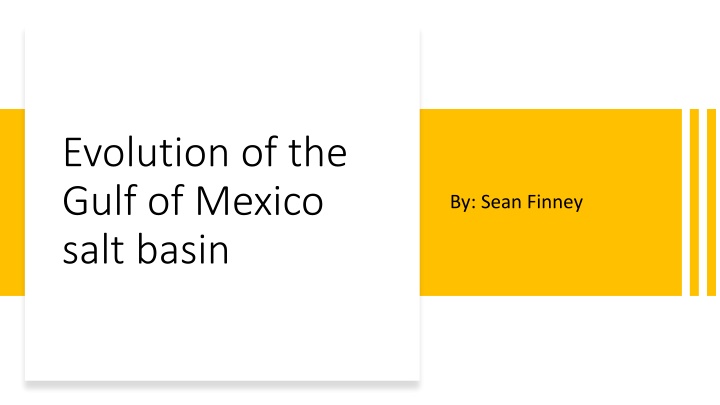
Evolution of Gulf of Mexico Salt Basin - Geologic Insights
Explore the evolutionary journey of the Gulf of Mexico's salt basin, from its formation during the Triassic to the present day. Delve into key terms, methodology, focused interpretations, and geologic history, providing a comprehensive overview of this geological phenomenon.
Download Presentation

Please find below an Image/Link to download the presentation.
The content on the website is provided AS IS for your information and personal use only. It may not be sold, licensed, or shared on other websites without obtaining consent from the author. If you encounter any issues during the download, it is possible that the publisher has removed the file from their server.
You are allowed to download the files provided on this website for personal or commercial use, subject to the condition that they are used lawfully. All files are the property of their respective owners.
The content on the website is provided AS IS for your information and personal use only. It may not be sold, licensed, or shared on other websites without obtaining consent from the author.
E N D
Presentation Transcript
Evolution of the Gulf of Mexico salt basin By: Sean Finney
Overview Gulf of Mexico Basin began forming during the Triassic-Early Cretaceous Rifting between Yucatan microplate and the North American plate. Two pieces of the salt basin Northern (Louann salt basin) southern (Isthmian salt basin). Yucatan Platform
Key Terms LOC- Limit of normal Oceanic Crust in the Gulf of Mexico Autochthonous- A large block or mass of rock which is in the place of its original formation relative to its basement or foundation rock. Allochthonous- Moved from the original site of formation. Parautochthonous- In between moved and not moved. Deep salt- deepest salt layer.
Methodology -Widely spaced two-dimensional Seismic Data -More recently large-scale three-dimensional data has been obtained. -Gravity and magnetic data not so good due to the great thickness of sediment.
Focused Interpretations 1.) LOC coincides with a landward-dipping ramp near the seaward end of the salt basin 2.) Deep salt in the deep-water Gulf of Mexico salt basin can be separated into provinces 3.) Salt filled the gulf of Mexico salt basin to near sea level 4.) Post salt sediments in the central Louann and Yucatan salt basins exhibit large magnitudes of Late Jurassic salt-detached extension, not balanced by equivalent salt detached shortening.
Geologic History Phase 1 Presalt rifting (210-163 Ma) Phase 2 Salt deposition (163-161 Ma) Post Salt crustal stretching (161- 154 to 149 Ma) Sea Floor Spreading (154-149 to 137 Ma) No index fossils makes age dating difficult
Outer Plain Outer Ramp Outer Basin Inner Ramp Inner basin Gulf of Mexico Salt Basin Geology
Outer Plain Subhorizontal sediments resting on the acoustic basement interpreted as normal (not salt) oceanic crust. In most places the edge of the outer plain is salt cored, frontal anticline.
Outer Ramp Salt can form anticlines or small diapirs here Base of the outer ramp is composed of alternating segments that are parallel to subsalt bedding (flats) and oblique (slanting) to subsalt bedding (ramps) Lack well data instead use regional correlations
-Salt sits directly on the acoustic basement -NW Regions large compressional anticlines -Elsewhere small relict salt pillows, turtle structures, salt diapirs Outer Basin
Rests on acoustic basement which dips landward at 4-10 degrees Major landward dipping monocline Inner Ramp Some areas seaward leaning diapirs are rooted at the top of the ramp Salt and salt related structures here are much larger
Due to great depth, it is poorly imaged Dips gently landward Inner Basin
References Cited Hudec, Michael R, et al. Jurassic Evolution of the Gulf of Mexico Salt Basin. Oct. 2013. Martinez, Joseph D. Www.jstor.org. American Scientist, 1991, https://www.jstor.org/stable/29774476?googleloggedin=true. How Does Marine Seismic Work? Rigzone, https://www.rigzone.com/training/insight?insight_id=303&c_id=.












